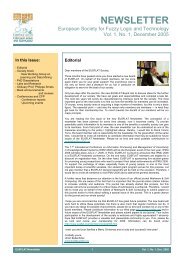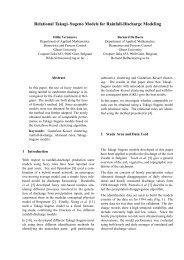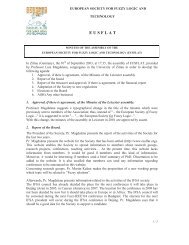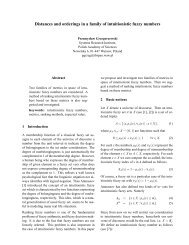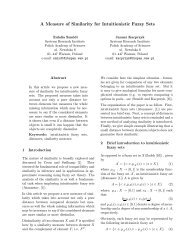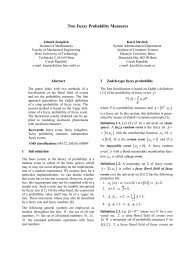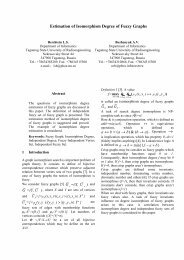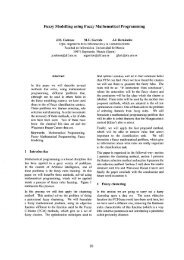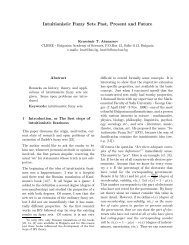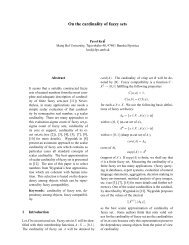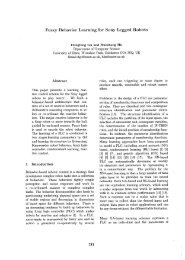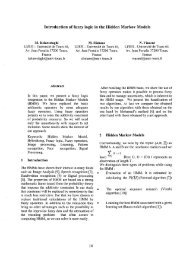Ant Colony Optimization for Distributed Routing ... - ResearchGate
Ant Colony Optimization for Distributed Routing ... - ResearchGate
Ant Colony Optimization for Distributed Routing ... - ResearchGate
Create successful ePaper yourself
Turn your PDF publications into a flip-book with our unique Google optimized e-Paper software.
a<br />
Average burst blocking probability<br />
a<br />
Average burst blocking probability<br />
1.0E+0 10 0<br />
1.0E-1 10 -1<br />
1.0E-2 10 -2<br />
1.0E-3 10 -3<br />
1.0E-4 10 -4<br />
1.0E-5 10 -5<br />
1.0E+0 10 0<br />
1.0E-1 10 -1<br />
1.0E-2 10 -2<br />
1.0E-3 10 -3<br />
1.0E-4 10 -4<br />
1.0E-5 10 -5<br />
Γ=0.45<br />
Γ=0.35<br />
Γ=0.25<br />
0.05 0.15 0.25 0.35 0.45 0.55 0.65 0.75<br />
Maximum pheromone increment per EAP, τmax<br />
Figure 4: Per<strong>for</strong>mance impact of τmax.<br />
Γ=0.45<br />
Γ=0.35<br />
Γ=0.25<br />
10 30 50 70 90 110 130 150 170 190<br />
Size of sliding window used to record the best EAP solution, Q<br />
Figure 5: Per<strong>for</strong>mance impact of Q.<br />
The results above consider three values of average offered<br />
traffic load in order to confirm that the behaviour observed is<br />
independent of the traffic load. According to the simulation<br />
results of Fig. 3, the loss per<strong>for</strong>mance slightly deteriorates as<br />
the minimum pheromone concentration on the adjacent<br />
nodes is increased. This is because the random component of<br />
routing the EAPs becomes larger, increasing the chances of<br />
modifications in the routing paths. In the limit case τmin=1,<br />
the network cannot optimize the set of routing paths.<br />
From Fig. 4, it can be seen that the average burst blocking<br />
probability is slightly increased as the EAPs are allowed to<br />
deposit more pheromone in a single trip. This behaviour is<br />
attributed to more frequent modifications of the routing paths<br />
as a consequence of increased fluctuations of the pheromone<br />
values. A smaller pheromone increment makes the routing<br />
paths less sensitive to the goodness of the solution found by a<br />
single artificial ant, which means they are changed only when<br />
a significant number of EAPs have followed a given routing<br />
path and confirmed its superior quality.<br />
As shown in Fig. 5, the use of a large Q can improve the<br />
network per<strong>for</strong>mance because it enhances the accuracy of the<br />
pheromone update process.<br />
Overall, given the relatively small range of variation of<br />
the average burst blocking probability, the results suggest<br />
ISBN: 978-989-95079-6-8<br />
IFSA-EUSFLAT 2009<br />
that DABR is quite robust to changes in its main parameters.<br />
The results also suggest that a larger Q and a smaller τmin and<br />
τmax slightly improve loss per<strong>for</strong>mance. However, it should<br />
be stressed that the simulations consider a single traffic<br />
pattern (in terms of average offered traffic load), whereas in<br />
more dynamic traffic scenarios a very large Q and very small<br />
τmin and τmax should be avoided because they can slow down<br />
the convergence to a new set of optimized routing paths<br />
whenever significant changes in the traffic pattern take place.<br />
6 Conclusions<br />
This paper has proposed a novel distributed routing path<br />
optimization framework <strong>for</strong> OBS networks based on ACO<br />
concepts. Simulation results have shown that the proposed<br />
framework can significantly improve network per<strong>for</strong>mance<br />
without needing to fine tune its parameters.<br />
References<br />
[1] M. Dorigo, M. Birattari and T. Stützle, <strong>Ant</strong> colony optimization:<br />
Artificial ants as a computational intelligence technique, IEEE<br />
Computational Intelligence Magazine, 1 (4): 28-39, Nov 2006.<br />
[2] E. Bonabeau, M. Dorigo and G. Theraulaz, Swarm Intelligence: From<br />
Natural to Artificial Systems, Ox<strong>for</strong>d University Press, 1999.<br />
[3] M. Dorigo and T. Stützle, <strong>Ant</strong> <strong>Colony</strong> <strong>Optimization</strong>, Cambridge: MIT<br />
Press, 2004.<br />
[4] R. Schoonderwoerd, O. Holland, J. Bruten and L. Rothkrantz, <strong>Ant</strong>based<br />
load balancing in telecommunications networks, Adaptive<br />
Behavior, 5 ( 2): 169-207, 1996.<br />
[5] G. Di Caro, and M. Dorigo, <strong>Ant</strong>Net: <strong>Distributed</strong> stigmergetic control<br />
<strong>for</strong> communications networks, Journal of Artificial Intelligence<br />
Research, 9: 317-365, 1998.<br />
[6] R. Garlick and R. Barr, Dynamic wavelength routing in WDM<br />
networks via ant colony optimization, in Proc. of International<br />
Workshop on <strong>Ant</strong> Algorithms (ANTS) 2002, 250-255, Brussels,<br />
Belgium.<br />
[7] S. Ngo, X. Jiang and S. Horiguchi, An ant-based approach to dynamic<br />
RWA in optical WDM networks, Photonic Network Communications,<br />
11 (1): 39-48, January 2006.<br />
[8] C. Qiao, and M. Yoo, Optical Burst Switching (OBS) – A new<br />
paradigm <strong>for</strong> an optical Internet, Journal of High Speed Networks, 8<br />
(1): 69-84, January 1999.<br />
[9] G. Pavani and H. Waldman, Traffic engineering and restoration in<br />
optical packet switching networks by means of ant colony<br />
optimization, in Proc. of BROADNETS 2006, San Jose, USA.<br />
[10] Y. Chen, C. Qiao and X. Yu, Optical burst switching: A new area in<br />
optical network research, IEEE Network, 18 (3): 16-23, May 2004.<br />
[11] J. Castro, J. Pedro and P. Monteiro, Burst loss reduction in OBS<br />
networks by minimizing network congestion, in Proc. of ConfTele<br />
2005, Tomar, Portugal.<br />
[12] G. Thodine, V. Vokkarane and J. Jue, Dynamic congestion-based load<br />
balanced routing in optical burst-switched networks, in Proc. of IEEE<br />
GLOBECOM 2003, 5: 2628-2632, San Francisco, USA.<br />
[13] K. Sim and W. Sun, <strong>Ant</strong> colony optimization <strong>for</strong> routing and loadbalancing:<br />
Survey and new directions, IEEE Transactions on Systems,<br />
Man, and Cybernetics, 33 (5): 560-572, September 2003.<br />
[14] F. Kelly, Loss networks, The Annals of Applied Probability, 1 (3):<br />
319-378, 1991.<br />
[15] J. Pedro, J. Castro, P. Monteiro and J. Pires, On the modelling and<br />
per<strong>for</strong>mance evaluation of optical burst-switched networks, in Proc.<br />
of IEEE CAMAD 2006, 30-37, Trento, Italy.<br />
183



